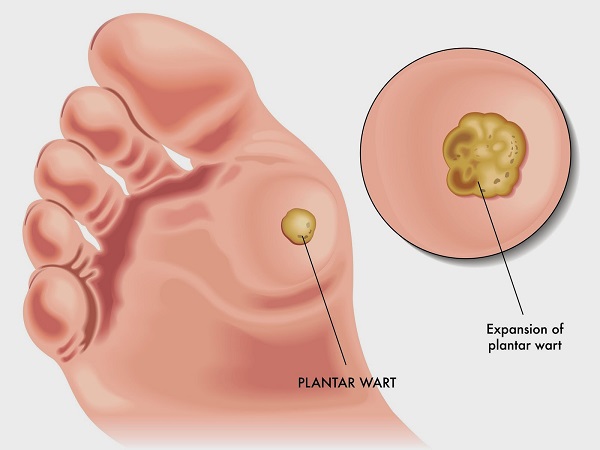Your feet encounter many elements that can result in rough skin, cracks, splits, and ultimately infections. We profile one of those by-products of foot infections, the plantar wart. This presentation includes a discussion of what causes plantar warts, the symptoms and treatments for these warts, and how you can prevent or reduce your chances of getting them. In explaining what causes plantar warts, you’ll also know how to distinguish the warts from other foot discomforts such as calluses.
What Are Plantar Warts?
Before getting into what causes plantar warts, we should first tell you a bit more about them. Plantar warts appear on your feet as small growths, usually the size of a pencil eraser. These areas can cluster into mosaic warts or otherwise increase in size.
These warts present with black dots, which are actually small blood vessels protruding into the wart. In many cases, warts might look similar to calluses on feet. The latter condition consists of hard, dead skin. The black dots help distinguish plantar warts from calluses on the foot. Additionally, plantar warts break the natural skin lines in the foot. With calluses, the natural lines continue through the callus.

Some plantar warts symptoms, which are discussed below, also help you tell whether you have plantar warts or calluses. In the former, the pain will result from squeezing them side to side. Calluses cause pain when squeezed upon directly.
What Causes Plantar Warts?
A plantar wart is an infection caused by the human papillomavirus, or HPV. Nearly eight out of ten people have an HPV infection at some point in their life. In many cases, the virus does not manifest itself with symptoms. The strain of HPV responsible for plantar warts represents one of many strains. The plantar wart strain is not cancerous, but some other strains can lead to cancer in the mouth, throat, anus, or rectum.
The HPV strain that causes plantar warts does not spread generally by person-to-person contact. Small cuts or separations in the foot furnish the openings for HPV to enter. Breeding grounds for HPV include warm, wet places such as swimming pools, locker rooms, and community showers or bathrooms.
The environments that promote plantar warts include those commonly used by children, teenagers and young adults. As a result, those in these groups are especially susceptible to plantar warts. Other risk factors include a prior history of plantar warts and having a weakened immune system.
What Are the Symptoms of Plantar Warts?
Plantar wart symptoms are seen and felt. As discussed already, you’ll notice an eraser-sized area with black dots. The skin will appear rough, with the natural skin lines being interrupted. This roughness resembles that found in calluses, but the latter does not come with dots or interrupt the natural skin lines.
You can also feel pain from plantar warts. Walking or standing can trigger such a symptom. The discomfort can range from mere tenderness to significant pain.
What Are the Treatments for Plantar Warts?
In many cases, plantar warts may resolve themselves over time and you may not even seek treatment. However, the pain or other reasons may prompt action.
If so, you can try these approaches:
- Duct tape: Apply a small strip of tape over the wart for six days. Upon removal of it, soak your foot in water, and then cut down the wart with an emery board or pumice stone. This may require several attempts over multiple months.
- Salicylic acid cream: This plantar wart treatment works to shed the skin from the wart. Its properties promote skin moisture, which facilitates the shedding. The treatment can take up to twelve weeks. Although salicylic acid cream can rid your feet of warts, it does not attack the HPV virus. Further, avoid placing the cream on your face and mouth.
- Essential oils: Lavender oil, garlic oil, lemon oil, and other essential oils contain vitamins and other ingredients that can heal and restore skin. Apply these essential oils with care. Other kitchen-based possibilities include apple cider vinegar, garlic, witch hazel, and baking soda.

- Treatment from a doctor: Your physician may employ wart removal measures using nitrogen to freeze the wart or laser therapy. To prevent infections, your doctor may inject you with medications to boost your immune system.
Most of these treatments take many tries and time, especially those of the home variety. This is because warts reside underneath the skin’s surface.
How Do I Prevent Plantar Warts?
Even with the best practices, plantar warts ultimately may not be avoidable. This is thanks to the prevalence of HPV. However, these measures can reduce your risk of getting plantar warts:
- Wear bathroom slippers or flip-flops in community showers, locker rooms, or at the pool.
- Keep your feet clean. Wash the soles and between toes.
- Use foot cream or foot moisturizer to avoid cracks and splits in your foot and between toes.
- Do not touch the warts. Wash your hands and use hand sanitizer.
- Wash your socks each time after you wear them.
- Use separate emery boards, pumice stone, nail clippers, and other foot-grooming devices for the foot with the wart from the healthy foot.
Plantar warts do not typically constitute an ominous health condition. However, they can irritate and annoy when you engage in certain daily activities on your feet. Although plantar warts may be unavoidable, you can use these treatments to lessen the impact and these prevention strategies to reduce your risk. What causes plantar warts for you? Please let us know if you have any other suggestions for dealing with plantar warts symptoms.

Leave a Comment